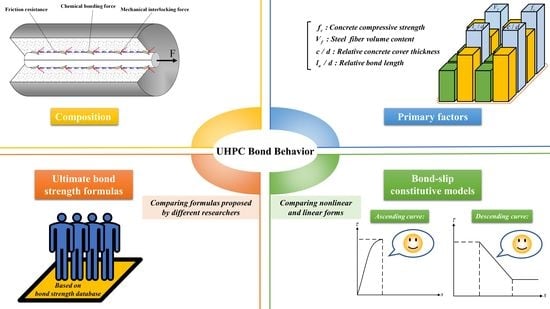Review of Bond-Slip Behavior between Rebar and UHPC: Analysis of the Proposed Models
Abstract
1. Introduction
2. Composition of Bond Behavior
3. Bond Test Types
3.1. Pull-Out Test
3.2. Beam-Type Test
4. Factors Affecting Bond Strength
4.1. Concrete Compressive Strength
4.2. Steel Fiber Volume Content
4.3. Relative Concrete Cover Thickness
4.4. Relative Bond Length
5. Ultimate Bond Strength Formula
6. Bond-Slip Constitutive Model
6.1. Ascending Curve
6.2. Descending Curve
6.3. Comparison between Linear and Non-linear Forms
6.4. Simulation of Bond Behavior in Finite Element Analysis (FEA)
7. Conclusions and Prospects
7.1. Conclusions
- The factors influencing the bond behavior between rebar and UHPFRC are categorized into three aspects: rebar, concrete, and test design. Among these factors, UHPFRC strength, rebar strength, steel fiber content, relative concrete cover thickness, and relative bond length are the primary factors that impact the bond behavior of UHPFRC.
- There are various expressions for the ultimate bond strength, most of which are empirical formulas derived from test results, while others are theoretical formulas involving numerous influencing factors. By referencing the test results of other researchers, it is observed that incorporating the primary effects of rebar, concrete, and test conditions leads to universal and accurate calculation models.
- The bond-slip constitutive relationship between rebar and UHPC has various forms. Using the nonlinear constitutive relation for the ascending branch reflects the bond behavior. Assuming that the residual bond stress is determined in the descending branch, the bi-linear form is superior to the nonlinear form. However, after fitting the parameters of the nonlinear descending segment based on the test results, the predictive ability of the nonlinear descending segment will be better than that of the bi-linear form.
7.2. Prospects
- UHPC or UHPFRC is used to construct bridges, buildings, and other structures. Considering the construction environment of the project, it is essential to account for the independent or coupled effects of high temperature, impact, freeze-thaw cycles, vibration, erosion, and other factors on the bond behavior. Additionally, the corresponding calculation model should be proposed according to the local environmental characteristics.
- Owing to the complex bond mechanism, the heterogeneous development of UHPC-related standards across different countries, and the variations in material selection and test conditions, there exist discrepancies among the results of different calculation models. While most models are applicable only within the range of the test parameters, only a few researchers have proposed theoretical calculation models based on the principles of elastic mechanics theory. Developing a universal calculation model based on the energy principle may be possible in future research.
- The prediction of bond behavior involves multiple parameters and nonlinear constitutive relationships. Pull-out test specimens are easily prepared in batches and demand simple experimental requirements. Therefore, collecting experimental parameters and results from various literature and compiling a database, the subsequent research on the bond behavior is conducted based on deep learning technology.
Author Contributions
Funding
Data Availability Statement
Acknowledgments
Conflicts of Interest
References
- Azmee, N.M.; Shafiq, N. Ultra-high performance concrete: From fundamental to applications. Case Stud. Constr. Mater. 2018, 9, e00197. [Google Scholar] [CrossRef]
- Shafieifar, M.; Farzad, M.; Azizinamini, A. Experimental and numerical study on mechanical properties of Ultra High Performance Concrete (UHPC). Constr. Build. Mater. 2017, 156, 402–411. [Google Scholar] [CrossRef]
- Amran, M.; Huang, S.-S.; Onaizi, A.M.; Makul, N.; Abdelgader, H.S.; Ozbakkaloglu, T. Recent trends in ultra-high performance concrete (UHPC): Current status, challenges, and future prospects. Constr. Build. Mater. 2022, 352, 129029. [Google Scholar] [CrossRef]
- Syed, A. Development of Ultra High Performance Fiber Reinforced Concrete; Aalto University: Espoo, Finland, 2018. [Google Scholar]
- Akhnoukh, A.K.; Buckhalter, C. Ultra-high-performance concrete: Constituents, mechanical properties, applications and current challenges. Case Stud. Constr. Mater. 2021, 15, e00559. [Google Scholar] [CrossRef]
- Graybeal, B.A. Flexural behavior of an ultra high-performance concrete I-girder. J. Bridge Eng. 2008, 13, 602–610. [Google Scholar] [CrossRef]
- Meng, W.; Khayat, K.H. Improving flexural performance of ultra-high-performance concrete by rheology control of suspending mortar. Compos. Part B Eng. 2017, 117, 26–34. [Google Scholar] [CrossRef]
- El-Din, H.K.S.; Mohamed, H.A.; Khater, M.A.E.-H.; Ahmed, S. Effect of steel fibers on behavior of ultra high performance concrete. Int. Interact. Symp. Ultra-High Perform. Concr. 2016, 1, 1–10. [Google Scholar] [CrossRef]
- Hung, C.; El-Tawil, S.; Chao, S. A review of developments and challenges for UHPC in structural engineering: Behavior, analysis, and design. J. Struct. Eng. 2021, 147, 03121001. [Google Scholar] [CrossRef]
- Bae, B.I.; Choi, H.K.; Choi, C.S. Evaluation of Bond Strength between Steel Fiber Reinforced Ultra-High Strength Concrete and Rebar. Key Eng. Mater. 2016, 665, 41–44. [Google Scholar] [CrossRef]
- Sturm, A.B.; Visintin, P. Local bond slip behavior of steel reinforcing bars embedded in ultra high performance fibre reinforced concrete. Struct. Concr. 2019, 20, 108–122. [Google Scholar] [CrossRef]
- An, M.; Zhang, M. Experimental Research of Bond Capability between Deformed Bars and Reactive Powder Concrete. China Railw. Sci. 2007, 28, 50–54. [Google Scholar]
- Jia, F. Experimental Study on Bond Properties between Steel Bar and Reactive Powder Concrete. Ph.D. Thesis, Beijing Jiaotong University, Beijing, China, 2013. [Google Scholar]
- Liu, X. Experimental Research on Bonding Properties between 150MPa High Performance Concrete and Deformed Bars. Master’s Thesis, Chongqing University, Chongqing, China, 2015. [Google Scholar]
- Zhang, Z.; Li, S.; Zhu, P.; Shao, X.; Bu, G. Test on Interface Bonding Behavior between Steel Rebar and Ultra-High Performance Concrete. J. Hunan Univ. 2022, 49, 105–115. [Google Scholar]
- Li, S. Bonding Behavior of the Interface between Steel Rebar and Ultra-High Performance Concrete. Master’s Thesis, Hunan University of Technology, Zhuzhou, China, 2022. [Google Scholar]
- Deng, Z.; Yuan, C. Experimental Study on Bond Capability between High Strength Rebar and Reactive Powder Concrete. China Civ. Eng. J. 2014, 47, 69–78. [Google Scholar] [CrossRef]
- Choi, H.K.; Bae, B.I.; Choi, C.S. Bond Characteristics and Splitting Bond Stress on Steel Fiber Reinforced Reactive Powder Concrete. J. Korea Concr. Inst. 2014, 26, 651–660. [Google Scholar] [CrossRef]
- Liang, R.; Huang, Y.; Xu, Z. Experimental and Analytical Investigation of Bond Behavior of Deformed Steel Bar and Ultra-High Performance Concrete. Buildings 2022, 12, 460. [Google Scholar] [CrossRef]
- Hu, A.; Liang, X.; Shi, Q.; Chen, Y.; Chen, B.; Wang, Q.; Li, R. Bond Characteristics between High Strength Bars and Ultra-High Performance Concrete. J. Xi’an Univ. Archit. Technol. 2021, 53, 534–544. [Google Scholar] [CrossRef]
- Hu, A.; Liang, X.; Shi, Q. Bond characteristics between high-strength bars and ultrahigh-performance concrete. J. Mater. Civ. Eng. 2020, 32, 04019323. [Google Scholar] [CrossRef]
- Holschemacher, K.; Weiße, D.; Klotz, S. Bond of reinforcement in ultra high strength concrete. In Proceedings of the International Symposium on UHPC, Kassel, Germany, 13–15 September 2004; pp. 375–387. [Google Scholar]
- Shao, Y.; Tich, K.L.; Boaro, S.B.; Billington, S.L. Impact of fiber distribution and cyclic loading on the bond behavior of steel-reinforced UHPC. Cem. Concr. Compos. 2022, 126, 104338. [Google Scholar] [CrossRef]
- Sun, M.; Gao, R.; Chen, Y.; Gao, M. Experimental Study of Bond behavior between High-Strength Rebar and Reactive Powder Concrete. Bridge Constr. 2016, 46, 18–23. [Google Scholar]
- Khaksefidi, S.; Ghalehnovi, M. Effect of reinforcement type on the tension stiffening model of Ultra-High Performance Concrete (UHPC). J. Rehabil. Civ. Eng. 2020, 8, 72–86. [Google Scholar] [CrossRef]
- Khaksefidi, S.; Ghalehnovi, M.; De Brito, J. Bond behaviour of high-strength steel rebars in normal (NSC) and ultra-high performance concrete (UHPC). J. Build. Eng. 2021, 33, 101592. [Google Scholar] [CrossRef]
- Alkaysi, M.; El-Tawil, S. Factors affecting bond development between Ultra High Performance Concrete (UHPC) and steel bar reinforcement. Constr. Build. Mater. 2017, 144, 412–422. [Google Scholar] [CrossRef]
- Zhou, Z.; Qiao, P. Bond behavior of epoxy-coated rebar in ultra-high performance concrete. Constr. Build. Mater. 2018, 182, 406–417. [Google Scholar] [CrossRef]
- Roy, M.; Hollmann, C.; Wille, K. Influence of volume fraction and orientation of fibers on the pullout behavior of reinforcement bar embedded in ultra high performance concrete. Constr. Build. Mater. 2017, 146, 582–593. [Google Scholar] [CrossRef]
- Frappa, G.; Pauletta, M.; Di Marco, C.; Russo, G. Experimental tests for the assessment of residual strength of r.c. structures after fire–Case Study. Eng. Struct. 2022, 252, 113681. [Google Scholar] [CrossRef]
- Tang, C.W. Effect of high temperatures on local bond–slip behavior between rebars and UHPC. Struct. Eng. Mech. 2022, 81, 163–178. [Google Scholar] [CrossRef]
- Fang, Z.; Chen, X.; Zhang, M.; Shan, R. Experimental Study on Performance of Lap-Spliced Ribbed Steel Bars in Reactive Powder Concrete. China Civ. Eng. J. 2019, 52, 20–28. [Google Scholar] [CrossRef]
- Ma, F.; Deng, M.; Sun, H.; Ye, W. Bond Behavior of Deformed Steel Bars Lap-Splice in Ultra High Performance Concrete. Acta Mater. Compos. Sin. 2021, 38, 3912–3924. [Google Scholar] [CrossRef]
- Chen, Y. Experimental and Analytical Study of Bond Behavior of High-Strength Reinforcing Steel in Ultra-High Performance Concrete. Master’s Thesis, Southeast University, Nanjing, China, 2020. [Google Scholar]
- Zhang, X.; Wu, X.; Zhang, X.; Wang, L.; Tang, Y.; Qiu, F. Bond behaviors of pre-and post-yield deformed rebar embedded in ultra-high performance concrete. Constr. Build. Mater. 2022, 341, 127839. [Google Scholar] [CrossRef]
- Qi, J.; Cheng, Z.; Ma, Z.J.; Wang, J.; Liu, J. Bond strength of reinforcing bars in ultra-high performance concrete: Experimental study and fiber–matrix discrete model. Eng. Struct. 2021, 248, 113290. [Google Scholar] [CrossRef]
- Pishro, A.A.; Feng, X. Experimental Study on Bond Stress between Ultra High Performance Concrete and Steel Reinforcement. Civ. Eng. J. 2017, 3, 1235–1246. [Google Scholar] [CrossRef]
- Pishro, A.A.; Feng, X.; Ping, Y.; Dengshi, H.; Shirazinejad, R.S. Comprehensive equation of local bond stress between UHPC and reinforcing steel bars. Constr. Build. Mater. 2020, 262, 119942. [Google Scholar] [CrossRef]
- Yang, T.; Xu, S.; Liu, Z.; Li, J.; Wu, P.; Yang, Y.; Wu, C. Experimental and numerical investigation of bond behavior between geopolymer based ultra-high-performance concrete and steel bars. Constr. Build. Mater. 2022, 345, 128220. [Google Scholar] [CrossRef]
- Xu, G.; Chen, B.; Zeng, J.; Gao, D.; Bao, H. Research on critical anchorage length of UHPC-CA and HTRB600E high-strength steel bars. Structures 2022, 41, 235–241. [Google Scholar] [CrossRef]
- Pan, R.; Liao, P.; Zou, J.; Zhou, X.; Li, C. Experimental investigation on bond performance of helically ribbed GFRP rebar embedded in Ultra-high performance concrete. Constr. Build. Mater. 2022, 357, 129295. [Google Scholar] [CrossRef]
- Xu, Y.; Shen, W.; Wang, H. Experimental Study on Bond and Anchorage Performance of Reinforced Concrete. J. Build. Struct. 1994, 26–37. [Google Scholar] [CrossRef]
- Goto, Y. Cracks formed in concrete around deformed tension bars. ACI J. 1971, 68, 244–251. [Google Scholar] [CrossRef]
- Somma, G.; Vit, M.; Frappa, G.; Pauletta, M.; Pitacco, I.; Russo, G. A new cracking model for concrete ties reinforced with bars having different diameters and bond laws. Eng. Struct. 2021, 235, 112026. [Google Scholar] [CrossRef]
- Akeed, M.H.; Qaidi, S.; Ahmed, H.U.; Emad, W.; Faraj, R.H.; Mohammed, A.S.; Tayeh, B.A.; Azevedo, A.R. Ultra-high-performance fiber-reinforced concrete. Part III: Fresh and hardened properties. Case Stud. Constr. Mater. 2022, 17, e01265. [Google Scholar] [CrossRef]
- Bahmani, H.; Mostofinejad, D. Microstructure of ultra-high-performance concrete (UHPC)–A review study. J. Build. Eng. 2022, 50, 104118. [Google Scholar] [CrossRef]
- Yang, J.; Chen, B.; Su, J.; Xu, G.; Zhang, D.; Zhou, J. Effects of fibers on the mechanical properties of UHPC: A review. J. Traffic Transp. Eng. 2022, 9, 363–387. [Google Scholar] [CrossRef]
- Yoo, D.-Y.; Shin, H.-O.; Yang, J.-M.; Yoon, Y.-S. Material and bond properties of ultra high performance fiber reinforced concrete with micro steel fibers. Compos. Part B Eng. 2014, 58, 122–133. [Google Scholar] [CrossRef]
- Gesoglu, M.; Güneyisi, E.; Muhyaddin, G.F.; Asaad, D.S. Strain hardening ultra-high performance fiber reinforced cementitious composites: Effect of fiber type and concentration. Compos. Part B Eng. 2016, 103, 74–83. [Google Scholar] [CrossRef]
- Wille, K.; Kim, D.J.; Naaman, A.E. Strain-hardening UHP-FRC with low fiber contents. Mater. Struct. 2011, 44, 583–598. [Google Scholar] [CrossRef]
- Liu, C.; Zhang, Y.; Yao, Y.; Huang, Y. Calculation method for flexural capacity of high strain-hardening ultra-high performance concrete T-beams. Struct. Concr. 2019, 20, 405–419. [Google Scholar] [CrossRef]
- Ragalwar, K. Systematic Development of Strain-Hardening Ultra-High Performance Concrete; State University of New York at Buffalo: Buffalo, NY, USA, 2019. [Google Scholar]
- Yoo, D.Y.; Yoon, Y.S. A review on structural behavior, design, and application of ultra-high-performance fiber-reinforced concrete. Int. J. Concr. Struct. Mater. 2016, 10, 125–142. [Google Scholar] [CrossRef]
- Guo, Z. Principles of Reinforced Concrete; Tsinghua University Press: Beijing, China, 1999; pp. 145–150. [Google Scholar]
- Reis, E.; de Azevedo, R.; Christoforo, A.; Poggiali, F.; Bezerra, A. Bonding of steel bars in concrete: A systematic review of the literature. Structures 2023, 49, 508–519. [Google Scholar] [CrossRef]
- He, S. Experimental Studies on Durability of Reinforced Concrete Members in Chloride Environment; Dalian University of Technology: Dalian, China, 2004. [Google Scholar]
- Wang, H.; He, S.; Gong, J. Experimental Studies on the Bond Character between Corroded Reinforcement and Concrete Subjected to Freeze-Thaw Cycles. Concrete 2007, 8, 1–3+10. [Google Scholar]
- Darwin, D.; Zuo, J.; Tholen, M.L.; Idun, E.K. Development Length Criteria for Conventional and High Relative Rib Area Reinforcing Bars; University of Kansas Center for Research, Inc.: Lawrence, KS, USA, 1995. [Google Scholar]
- Cheng, X. Study of the Strengthening Mechanism and Fracture Toughness of Steel Fiber Reinforced Concrete; Hohai University: Nanjing, China, 2005. [Google Scholar]
- Yang, M. Strengthening and Toughening Mechanism of Steel Fiber Reinforced High-Strength Concrete and Design Method Based on Toughness; Dalian University of Technology: Liaoning, China, 2006. [Google Scholar]
- Gao, D. Design and Application of Steel Fiber Reinforced Concrete; China Architecture & Building Press: Beijing, China, 2002; pp. 18–21. [Google Scholar]
- Wu, Z.; Shi, C.; He, W.; Wu, L. Effects of steel fiber content and shape on mechanical properties of ultra high performance concrete. Constr. Build. Mater. 2016, 103, 8–14. [Google Scholar] [CrossRef]
- Sahmaran, M.; Yaman, I. Hybrid fiber reinforced self-compacting concrete with a high-volume coarse fly ash. Constr. Build. Mater. 2007, 21, 150–156. [Google Scholar] [CrossRef]
- Yao, W.; Li, J.; Wu, K. Mechanical properties of hybrid fiber-reinforced concrete at low fiber volume fraction. Cem. Concr. Res. 2003, 33, 27–30. [Google Scholar] [CrossRef]
- Kusumawardaningsih, Y.; Fehling, E.; Ismail, M.; Aboubakr, A.A.M. Tensile strength behavior of UHPC and UHPFRC. Procedia Eng. 2015, 125, 1081–1086. [Google Scholar] [CrossRef]
- Yu, R.; Zhang, J.; Liu, K.; Liao, M.; Shui, Z.; Zeng, M.; Hu, F.; Hou, D.; Wang, X. Evaluation and regulation of Ultra-High Performance Concrete (UHPC) crack resistance based on physicochemical multi-factor coupling approach. Constr. Build. Mater. 2021, 301, 124100. [Google Scholar] [CrossRef]
- Liang, R.; Huang, Y. Experimental Study on Bond behavior between High Strength Steel Rebar and Ultra-High Performance Concrete. J. Build. Struct. 2022, 43, 294–302. [Google Scholar] [CrossRef]
- Le Hoang, A.; Fehling, E. Influence of steel fiber content and aspect ratio on the uniaxial tensile and compressive behavior of ultra high performance concrete. Constr. Build. Mater. 2017, 153, 790–806. [Google Scholar] [CrossRef]
- Shi, G.; Shao, X.; Gao, L.; Cao, J.; Chen, L. Experimental Research on Bond behavior between HRB400 Rebar and Ultra-High Performance Concrete. Bridge Constr. 2021, 51, 61–67. [Google Scholar]
- Marchand, P.; Baby, F.; Khadour, A.; Battesti, T.; Rivillon, P.; Quiertant, M.; Nguyen, H.-H.; Généreux, G.; Deveaud, J.-P.; Simon, A.; et al. Bond behaviour of reinforcing bars in UHPFRC. Mater. Struct. 2016, 49, 1979–1995. [Google Scholar] [CrossRef]
- Ronanki, V.S.; Aaleti, S.; Valentim, D.B. Experimental investigation of bond behavior of mild steel reinforcement in UHPC. Eng. Struct. 2018, 176, 707–718. [Google Scholar] [CrossRef]
- Li, Y.; Li, S.; Qiao, J.; Pan, J. Experimental research on bond behaviour between high-strength steel bars and ultra-high-performance fibre-reinforced concrete. Structures 2023, 50, 859–869. [Google Scholar] [CrossRef]
- Liu, H.; Liu, Y.; Li, A.; Lei, H. Experimental study on the bond performance of deformed steel bar in ultrahigh performance concrete. Case Stud. Constr. Mater. 2023, 18, e01874. [Google Scholar] [CrossRef]
- Hung, C.; Chen, Y.; Yen, C. Workability, fiber distribution, and mechanical properties of UHPC with hooked end steel macro-fibers. Constr. Build. Mater. 2020, 260, 119944. [Google Scholar] [CrossRef]
- Dupont, D.; Vandewalle, L. Distribution of steel fibres in rectangular sections. Cem. Concr. Compos. 2005, 27, 391–398. [Google Scholar] [CrossRef]
- Zuo, J.; Darwin, D. Bond Slip of High Relative Rib Area Bars Under Cyclic Loading. ACI Struct. J. 2000, 97, 331–334. [Google Scholar]
- Zhang, Y. Study on Bond Behavior between HRB500 Steel Bars and Reactive Powder Concrete. New Build. Mater. 2017, 44, 63–66. [Google Scholar]
- Kook, K.-H.; Shin, H.-O.; Kwahk, I.-J.; Yoon, Y.-S. Bond Characteristics of Ultra High Performance Concrete. J. Korea Concr. Inst. 2010, 22, 753–760. [Google Scholar] [CrossRef]
- Shao, Y.; Ostertag, C.P. Bond-slip behavior of steel reinforced UHPC under flexure: Experiment and prediction. Cem. Concr. Compos. 2022, 133, 104724. [Google Scholar] [CrossRef]
- Cheng, D.; Fan, Y.; Wang, Y. Bond-slip Constitutive Model of Steel Bars and Reactive Powder Concrete under Standard Curing. J. Jilin Univ. 2021, 51, 1317–1330. [Google Scholar] [CrossRef]
- Chu, S.; Kwan, A. A new bond model for reinforcing bars in steel fibre reinforced concrete. Cem. Concr. Compos. 2019, 104, 103405. [Google Scholar] [CrossRef]
- Kim, B.; Doh, J.-H.; Yi, C.-K.; Lee, J.-Y. Effects of structural fibers on bonding mechanism changes in interface between GFRP bar and concrete. Compos. Part B 2013, 45, 768–779. [Google Scholar] [CrossRef]
- Liang, R.; Huang, Y.; Xu, Z. Numerical Simulation of Lap-Spliced Ultra-High-Performance Concrete Beam Based on Bond–Slip. Buildings 2022, 12, 1257. [Google Scholar] [CrossRef]
- Dey, A.; Valiukas, D.; Jakubovskis, R.; Sokolov, A.; Kaklauskas, G. Experimental and Numerical Investigation of Bond-Slip Behavior of High-Strength Reinforced Concrete at Service Load. Materials 2022, 15, 293. [Google Scholar] [CrossRef] [PubMed]
- Li, M.; Liu, Z.; Yang, Z.; Wang, Z.; Yuan, H. Bond-slip behaviors between reinforced concrete and coated rebar via a new strain monitoring method and FEA simulation. Constr. Build. Mater. 2020, 262, 120402. [Google Scholar] [CrossRef]
- Kytinou, V.; Kosmidou, P.; Chalioris, C. Numerical Analysis Exterior RC Beam-Column Joints with CFRP Bars as Beam’s Tensional Reinforcement under Cyclic Reversal Deformations. Appl. Sci. 2022, 12, 7419. [Google Scholar] [CrossRef]
- Abaqus. Abaqus 6.1 Analysis User’s Manual; Simulia: Johnston, RI, USA, 2011. [Google Scholar]
- Rolland, A.; Argoul, P.; Benzarti, K.; Quiertant, M.; Chataigner, S.; Khadour, A. Analytical and numerical modeling of the bond behavior between FRP reinforcing bars and concrete. Constr. Build. Mater. 2020, 231, 117160. [Google Scholar] [CrossRef]

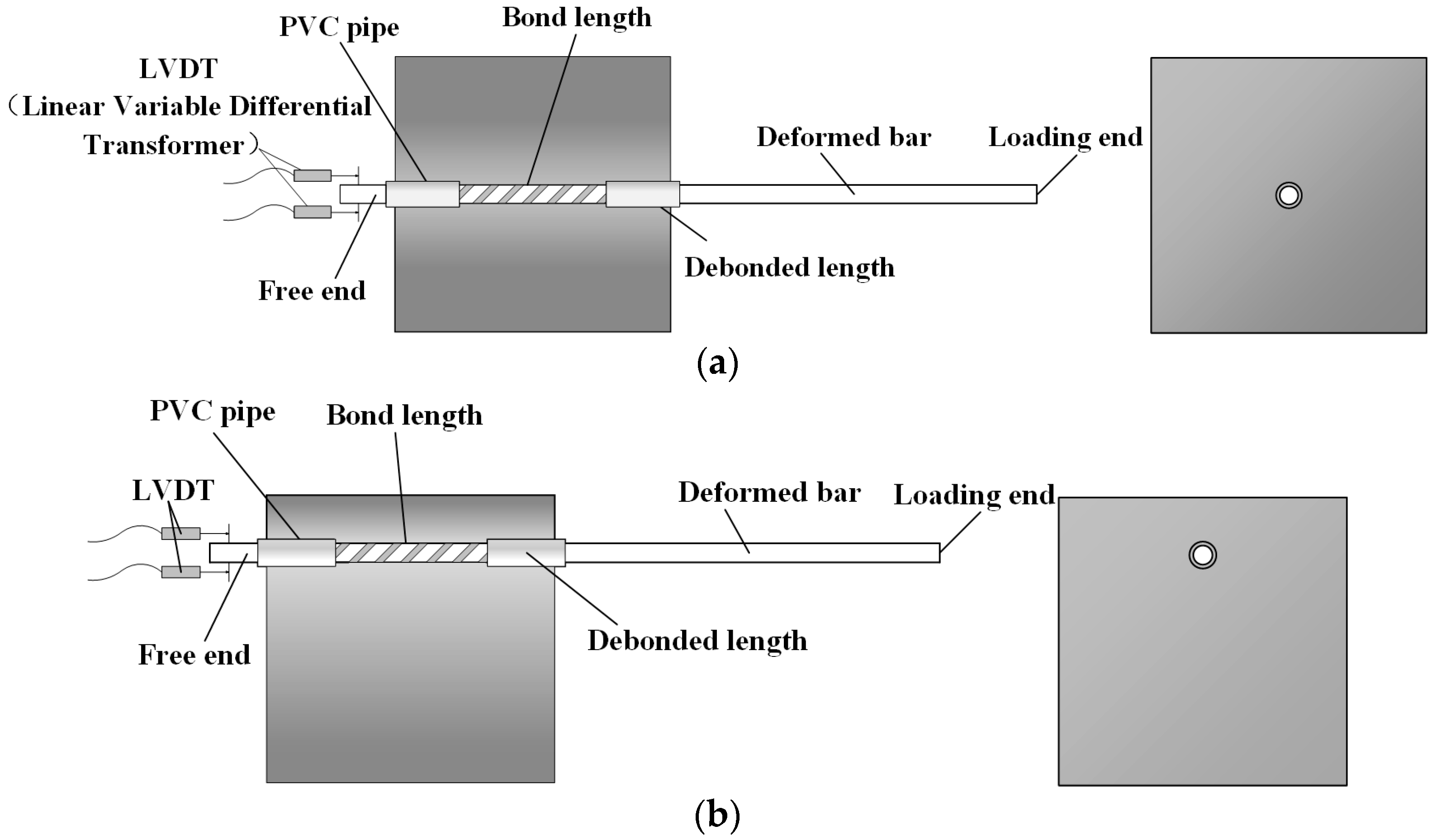


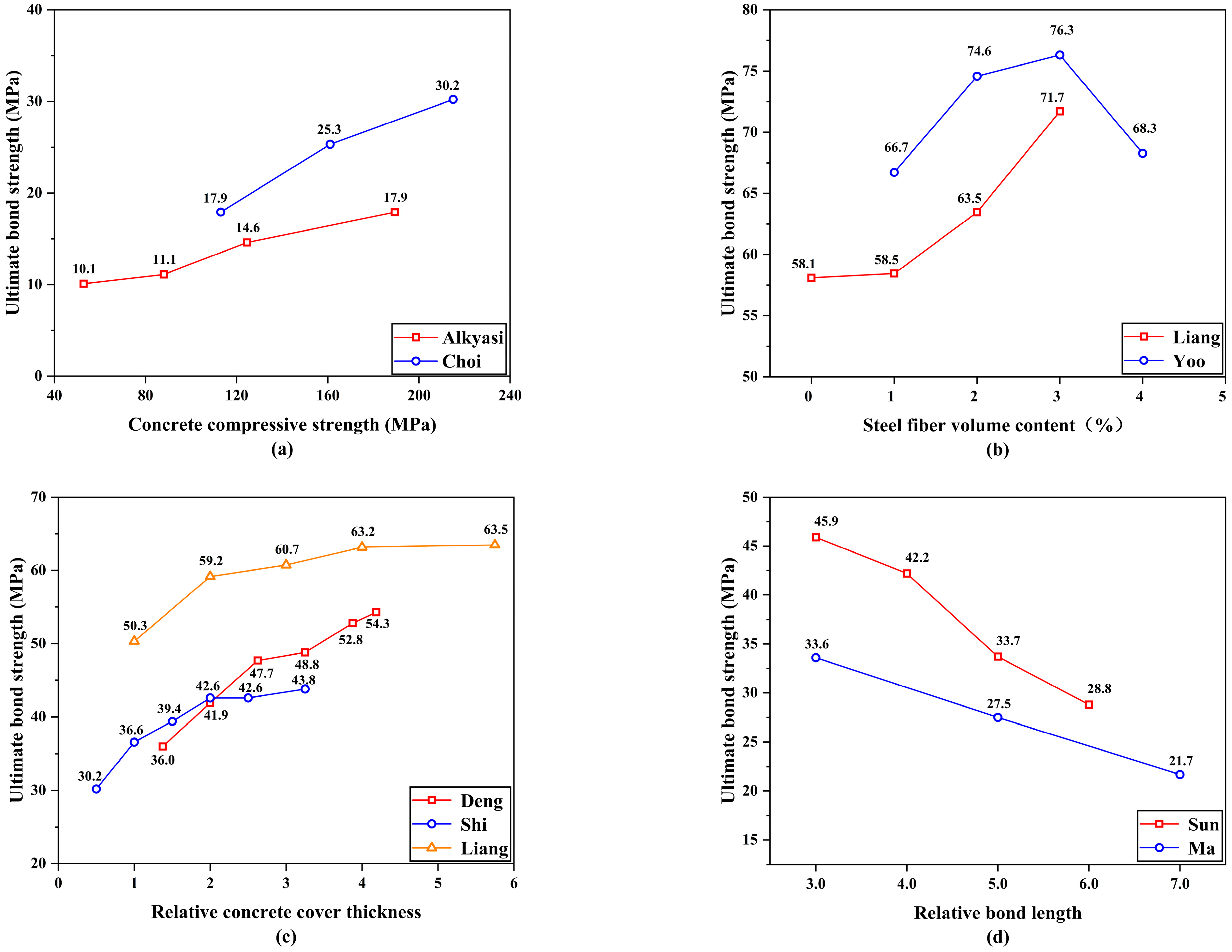


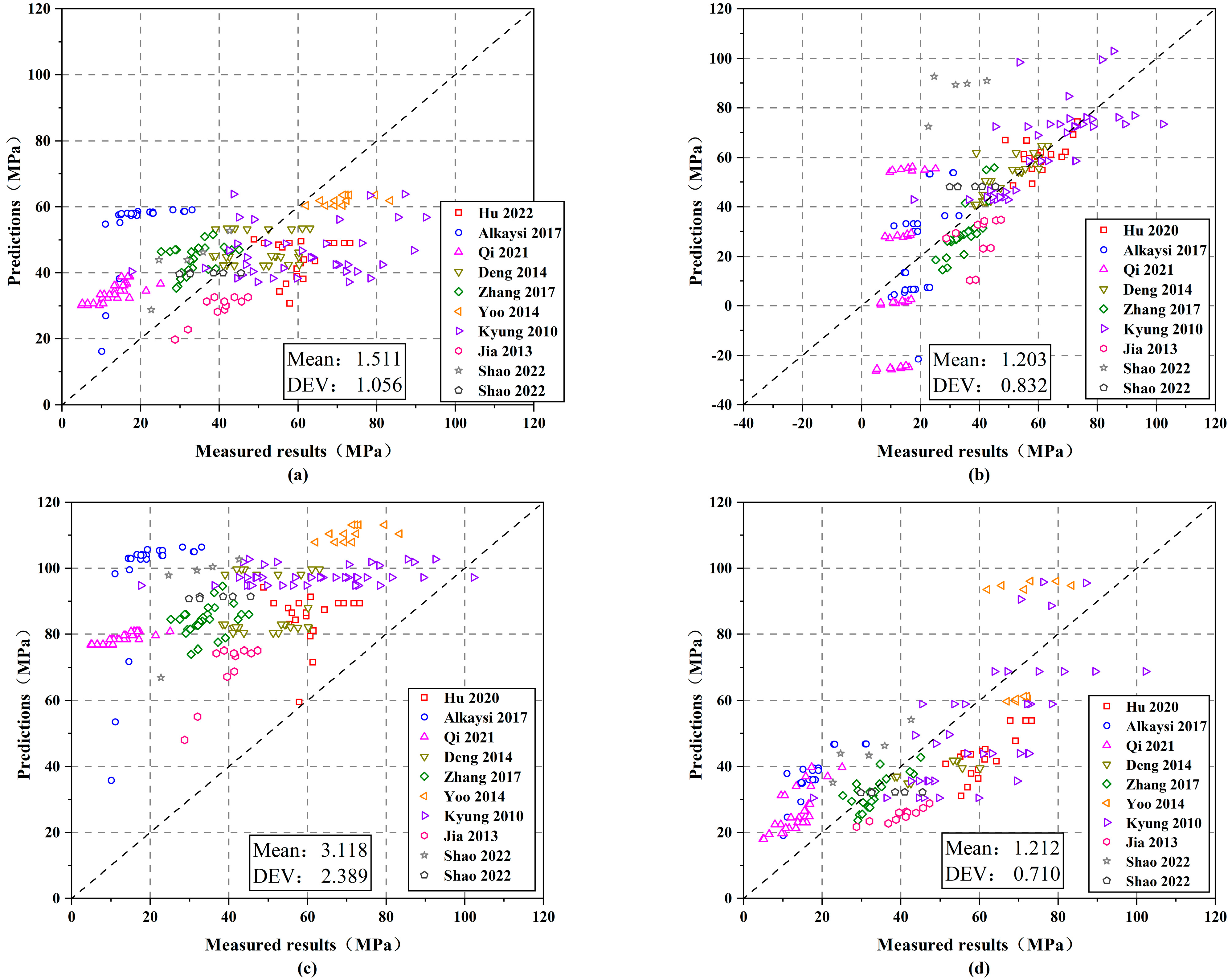

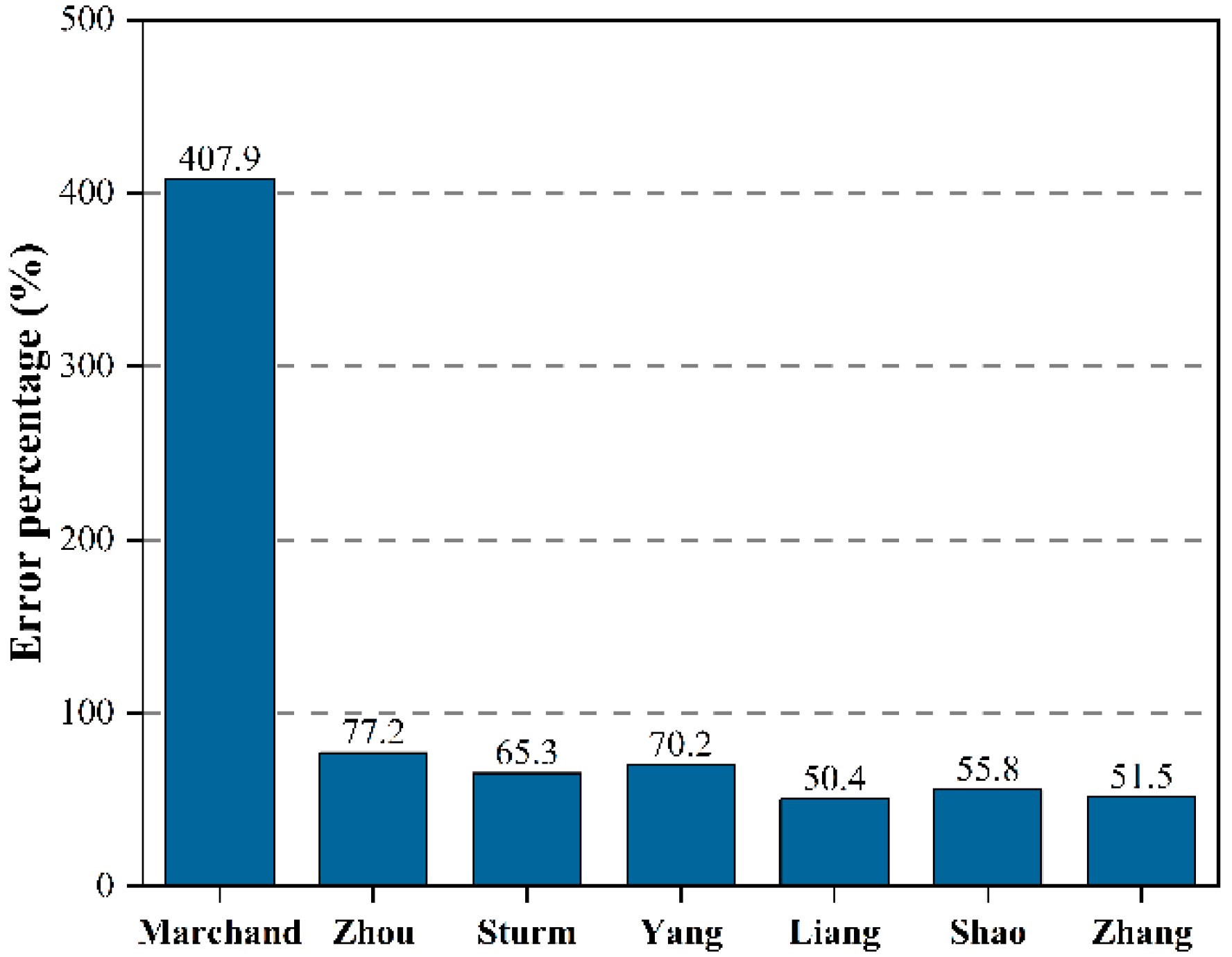
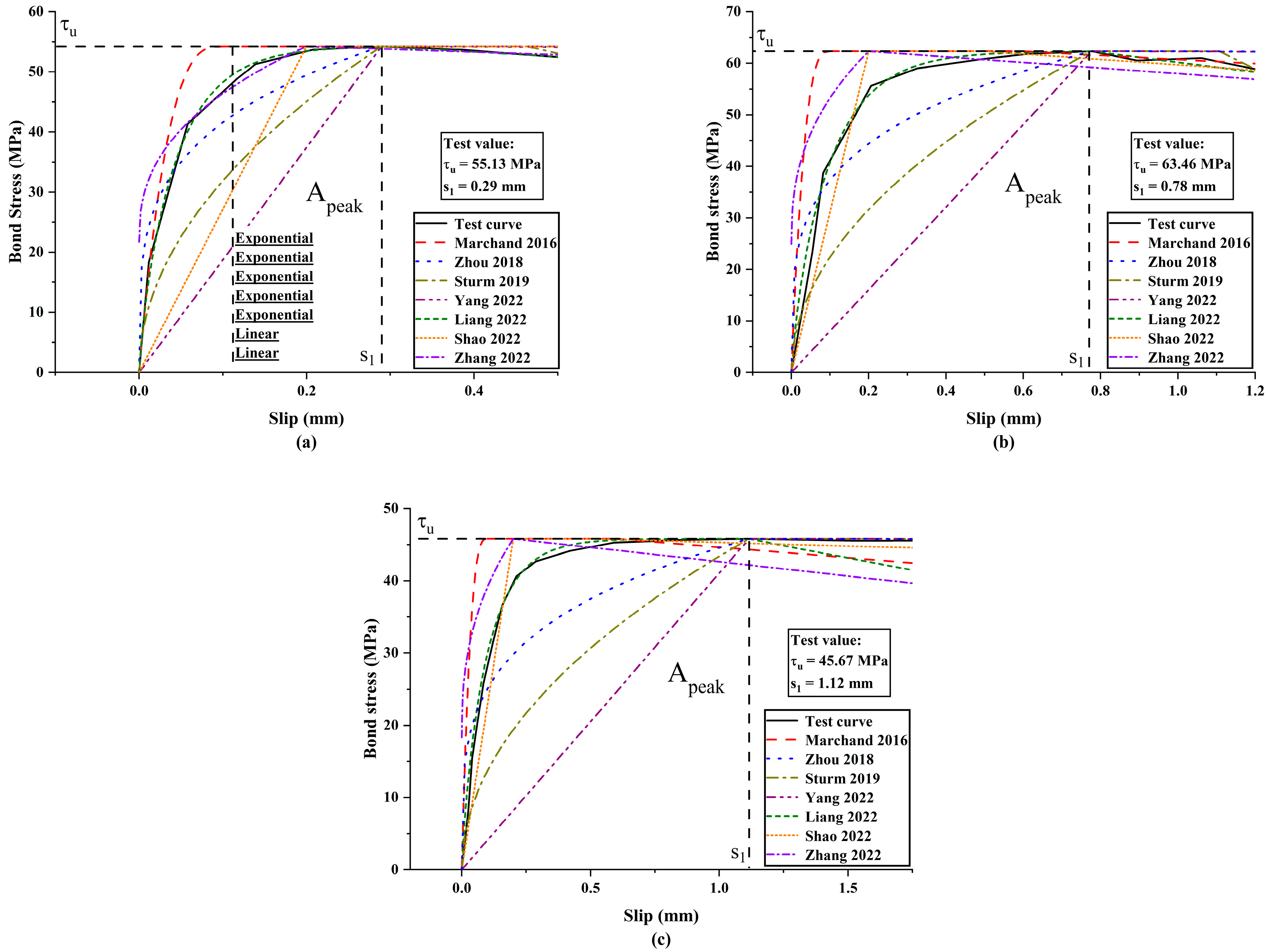
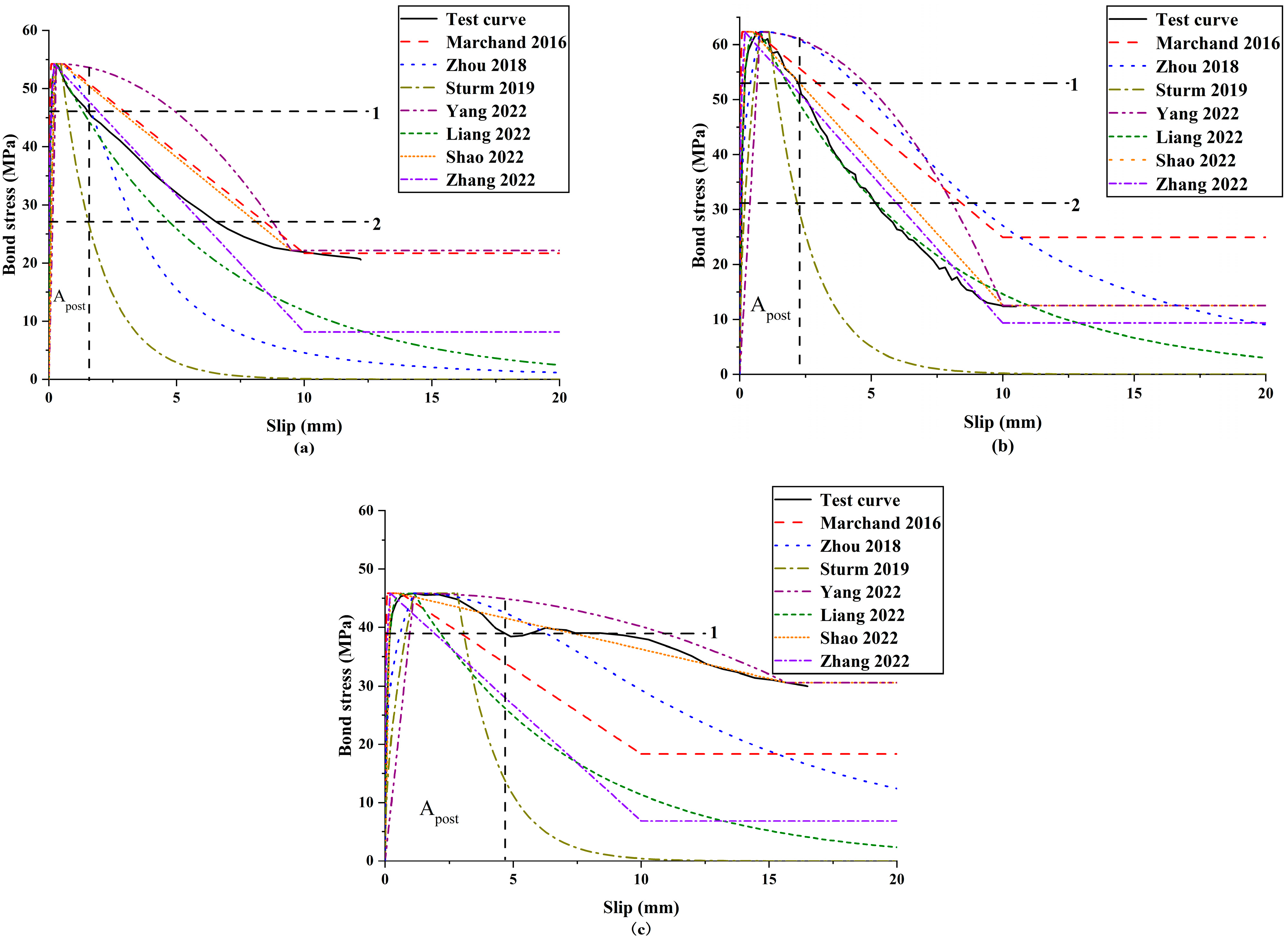

| References | Equations |
|---|---|
| An and Zhang [12] | ; |
| Jia [13] | |
| Deng and Yuan [17] | |
| Liu [14] | |
| Sun et al. [24] | ; |
| Roy et al. [29] | |
| Sturm and Visintin [11] | |
| Khaksefidi et al. [26] | |
| Fang et al. [32] | ; |
| Pishro et al. [38] | |
| Hu et al. [21] | |
| Chen [34] | ; |
| Ma et al. [33] | Anchorage: Lap: , when is greater than 5, takes 5. |
| Yang et al. [39] | |
| Liang et al. [19] | ; |
| Li [16] | Formula for 16 mm diameter rebar: Formula for 12 mm diameter rebar: Formula for 8 mm diameter rebar: |
| Li et al. [72] | |
| Liu et al. [73] | Linear regression model: Nonlinear regression model: |
| References | Number | (MPa) | (mm) | (%) | (mm) | (mm) | (MPa) | (MPa) | |
|---|---|---|---|---|---|---|---|---|---|
| Hu et al. [21] | 19 | 100.2–159.8 | 20–56 | 0–3.0 | 16–71 | 8–25 | 442.3–618.0 | 581.1–791.9 | 7/0.18 |
| Alkaysi and El-Tawil [27] | 25 | 88.0–191.0 | 50–100 | 1.0–2.0 | 65.5–68.5 | 13–19 | 415.5–497.9 | 586.4–707.7 | 19/0.2 |
| Qi et al. [36] | 32 | 150.4 | 32–160 | 2.0 | 8–40 | 16–20 | 428.4–437.2 | 573.4–586.3 | 13/0.2 |
| Deng and Yuan [17] | 27 | 135.3–170.7 | 24–72 | 1.5–3.0 | 66–71 | 8–18 | 566.7–589.4 | 682.0–738.9 | 13/0.2 |
| Zhang [77] | 27 | 132.2–166.3 | 18–120 | 1.0–2.0 | 25–70 | 10–20 | 454.8–573.6 | — | 12/0.22 |
| Yoo et al. [48] | 12 | 184.9–207.2 | 16–32 | 1.0–4.0 | 67 | 16 | — | 607.0–766.0 | 13/0.2 |
| Kyung et al. [78] | 40 | 183.3 | 9.5–66.6 | 2.0 | 9.5–90 | 10–22 | 400.0–700.0 | — | 13/0.2 |
| Jia [13] | 11 | 88.7–141.2 | 50–80 | 0–2.0 | 15–25 | 16 | 378.0 | 550.0 | 13~15/0.22 |
| Shao and Ostertag [79] | 5 | 124.8–189.6 | 30–40 | 1.0 | 25–51 | 16–25 | 713.0–721.0 | — | 13/0.2 |
| Shao et al. [23] | 6 | 172.7–174.0 | 48 | 1.0–2.0 | 24 | 16 | 470.0 | 674.0 | 13/0.2 |
| References | Constitutive Model |
|---|---|
| Yoo et al. [48] | ; , |
| Liu [14] | |
| Marchand et al. [70] | ; , , , is distance between rebar ribs, |
| Zhou and Qiao [28] | Ascending: Descending: , |
| Sturm and Visintin [11] | Splitting failure: Pull-out failure: ; , |
| Cheng et al. [80] | ; |
| Yang et al. [39] | ; , , , |
| Liang et al. [19] | Ascending: Descending: , , |
| Shao et al. [23] | ; , |
| Zhang et al. [35] | ; Before rebar yields: ; ; ; is distance between rebar ribs; After rebar yields: ; ; ; ; |
| References | ||
|---|---|---|
| Marchand | 3.000 | — |
| Zhou | 0.250 | 0.010 |
| Sturm | 0.500 | 0.645 |
| Yang | — | — |
| Liang | 0.805 | 0.157 |
| Shao | — | — |
| Zhang | 0.400 | — |
| References | Number | Marchand | Zhou | Sturm | Yang | Liang | Shao | Zhang | |
|---|---|---|---|---|---|---|---|---|---|
| Hu et al. [21] | 20 | 85% | 34.0% | 47.9% | 61.6% | 100.0% | 33.1% | 66.1% | 55.8% |
| 15 | 50% | 30.8% | 81.2% | 84.7% | 19.9% | 48.0% | 16.9% | 29.8% | |
| Liang and Huang [67] | 22 | 85% | 84.6% | 50.4% | 58.8% | 119.5% | 30.9% | 40.4% | 129.0% |
| 21 | 50% | 95.4% | 74.8% | 73.1% | 59.8% | 21.6% | 42.8% | 99.2% | |
| Zhang et al. [15] | 21 | 85% | 30.9% | 44.3% | 56.8% | 41.0% | 33.1% | 26.2% | 66.5% |
| 13 | 50% | 44.8% | 66.7% | 73.5% | 28.3% | 19.6% | 27.3% | 48.0% |
Disclaimer/Publisher’s Note: The statements, opinions and data contained in all publications are solely those of the individual author(s) and contributor(s) and not of MDPI and/or the editor(s). MDPI and/or the editor(s) disclaim responsibility for any injury to people or property resulting from any ideas, methods, instructions or products referred to in the content. |
© 2023 by the authors. Licensee MDPI, Basel, Switzerland. This article is an open access article distributed under the terms and conditions of the Creative Commons Attribution (CC BY) license (https://creativecommons.org/licenses/by/4.0/).
Share and Cite
Huang, Y.; Liu, Y. Review of Bond-Slip Behavior between Rebar and UHPC: Analysis of the Proposed Models. Buildings 2023, 13, 1270. https://doi.org/10.3390/buildings13051270
Huang Y, Liu Y. Review of Bond-Slip Behavior between Rebar and UHPC: Analysis of the Proposed Models. Buildings. 2023; 13(5):1270. https://doi.org/10.3390/buildings13051270
Chicago/Turabian StyleHuang, Yuan, and Yuming Liu. 2023. "Review of Bond-Slip Behavior between Rebar and UHPC: Analysis of the Proposed Models" Buildings 13, no. 5: 1270. https://doi.org/10.3390/buildings13051270
APA StyleHuang, Y., & Liu, Y. (2023). Review of Bond-Slip Behavior between Rebar and UHPC: Analysis of the Proposed Models. Buildings, 13(5), 1270. https://doi.org/10.3390/buildings13051270



